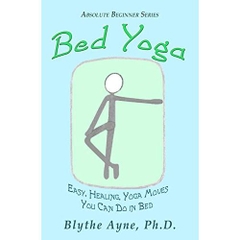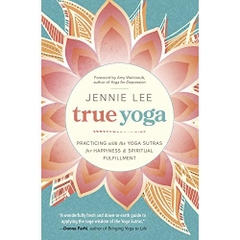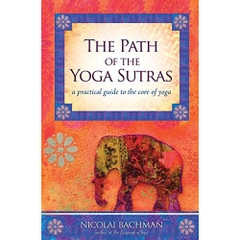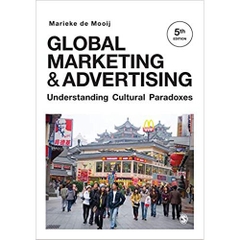-
-
-
Tổng tiền thanh toán:
-
-
Thông tin
-
Tìm sách theo yêu cầu
From the foremost living authority on Yoga comes the most comprehensive and reliable treatment of the subject available today. This is a work of impeccable scholarship by a person who has dedicated his life to the understanding and practice of yoga. The book offers a complete overview of every Yogic tradition, from the familiar to the lesser-known forms. It also covers all aspects of Hindu, Buddhist and Jaina Yoga, including history, philosophy, literature, psychology and practice. In addition, included are * translations of twenty Yoga treatises * the first translation of the Goraksha Paddhati
- Link: http://www.amazon.com/Yoga-Tradition-Literature-Philosophy-Practice/dp/1890772186
Product Details
Paperback: 550 pages
- Publisher: Hohm Press; 3rd edition (October 31, 2001)
- Language: English
- ISBN-10: 1890772186
- ISBN-13: 978-1890772185
- Product Dimensions: 10.8 x 8.5 x 1 inches
- Shipping Weight: 2.8 pounds (View shipping rates and policies)
- Average Customer Review: 4.3 out of 5 stars See all reviews (39 customer reviews)
- Amazon Best Sellers Rank: #22,006 in Books (See Top 100 in Books)
- #67 in Books > Health, Fitness & Dieting > Exercise & Fitness > Yoga
Editorial Reviews
From Booklist
Feuerstein is a renowned yoga scholar and a tireless communicator, sharing his knowledge in more than two dozen books on the subject as well as translations of key yoga scriptures. Most Westerners have a limited understanding of what the term yoga, which means "union," implies. Feuerstein describes yoga as a "spectacularly multifaceted phenomena," and performs a truly yogic feat by combining commentary with translated Sanskrit teachings, history with theory, the spiritual with the practical, and the classical with the contemporary. He illuminates every facet and phase of yoga from its roots in shamanism to its connections to the complex and dynamic spirituality of India, especially yoga's relationship with Hinduism and Buddhism. Feuerstein explicates the different yogic schools and profiles key yoga teachers. Yoga is a vast and vital universe maintained over the centuries by the discipline and persistence of its practitioners, who strive to join the physical with the spiritual, the "individual self with the supreme Self." No more adept or comprehensive study of yoga aimed at a Western audience is to be found. Donna Seaman --This text refers to an out of print or unavailable edition of this title.
Review
Without a doubt the finest overall explanation of Yoga ... Destined to become a classic. -- Ken Wilber, author of A Brief History of Everything.
Most Helpful Customer Reviews
118 of 125 people found the following review helpfulBy Dennis Littrell HALL OF FAMETOP 500 REVIEWERVINE VOICE on February 7, 2002
Format: Hardcover
4 Comments Was this review helpful to you? YesNoThis extraordinary work represents a lifetime of devotion to yoga by its preeminent Western scholar. It is at once a distillation and compilation of all that Georg Feuerstein has gleaned in his extensive travels both academically and spiritually. It greatly broadens the usual scope of yoga to include its manifestation in other religions and goes back in time to the edge of the prehistory. Feuerstein understands that yoga is both an ancient practice, and, by itself, a profound and venerable religion. More than anything, however, it is a salient expression of the culture and philosophy, the lifestyle and history of the Indian subcontinent where it was the midwife of the great religions of Buddhism, Jainism, Taoism and of course that great body of belief and practice known as Hinduism.
Feuerstein is in one sense a true believer. He has devoted his life to the study of yoga and attendant phenomena, in particular Hinduism and the broad Tantric tradition. One gets the sense that even here in this lengthy work, he knows much more than he is conveying; that there is a synergistic power in his extensive knowledge that allows him to know things that he cannot express. One feels his intense desire to say something that perhaps cannot be said, something spiritual and personal that can only be experienced.
In another sense he is a hard-working scholar who reports on what he has learned without passing unnecessary judgments or drawing unwarranted conclusions, although he does interpret. He is, in this sense, the American expression of the great Romanian scholar Mircea Eliade (who wrote in French) with perhaps a pinch of the Indian philosopher Sri Aurobindo, on the one hand, and the English tantrist Sir John Woodroffe, on the other, folded in.
The book begins with a thorough definition of yoga and then an overview, and then its inescapable conjoining with Hinduism. This is "Part One: Foundations." Then Feuerstein looks at "Pre-Classical Yoga" and overviews the entire Vedic tradition including the yoga of the earliest Upanishads, culminating in its expression in the Bhagavad Gita. Then in "Part Three: Classical Yoga," he comes to Patanjali and the yoga of the eight limbs, the famous yoga of the aphorisms. Part Four is "Post-Classical Yoga" from the later Yoga-Upanishads from the Middle Ages in which the focus is on bhakti, technique, mantra and meditation. It is here that Western readers will find much that is new, or at least not readily available in English. And it is here that a non-dualistic yogic philosophy (as opposed to the dualism of Patanjali) holds sway. Part Five is on tantrism and "Yoga as Spiritual Alchemy." It is in this last part that the so-called "subtle body," with its nadis and pranas, its cakras ("psychoenergetic centers") and the mysterious serpent power of kundalini, is explored in depth. Here too we have the ritualistic practice of the five forbidden things from tantra yoga, the infamous "left-handed path." Here is Feuerstein's take: "Practitioners of the left-hand path (<vâma-mârga>)--vâma means both "left" and "woman"--know they are breaking profound social taboos, and their only justification for their conduct is that their goal is not sensual gratification but self-transcendence in the context of bodily existence." (p. 484)
To me--and I have studied and practiced yoga for 28 years--yoga is first and foremost a profound psychology, a way of life that has evolved along with the human experience, from the prehistory to today, a guide on how to live that has come down to us in part (only in part: so much has been lost) as a philosophic and religious tradition. Feuerstein's book is at once a great reference and a heart-felt exposition on the power of yoga to transcend this world in which we are enveloped in the "food sheath," where we are both the eater and the eaten, but with our eyes on the stars.
The book includes numerous black and white illustrations, passages from yogic works, and an extensive, selected bibliography. There is a chronology, a glossary and an excellent index.
--Dennis Littrell, author of "Yoga: Sacred and Profane (Beyond Hatha Yoga)"
Feuerstein is in one sense a true believer. He has devoted his life to the study of yoga and attendant phenomena, in particular Hinduism and the broad Tantric tradition. One gets the sense that even here in this lengthy work, he knows much more than he is conveying; that there is a synergistic power in his extensive knowledge that allows him to know things that he cannot express. One feels his intense desire to say something that perhaps cannot be said, something spiritual and personal that can only be experienced.
In another sense he is a hard-working scholar who reports on what he has learned without passing unnecessary judgments or drawing unwarranted conclusions, although he does interpret. He is, in this sense, the American expression of the great Romanian scholar Mircea Eliade (who wrote in French) with perhaps a pinch of the Indian philosopher Sri Aurobindo, on the one hand, and the English tantrist Sir John Woodroffe, on the other, folded in.
The book begins with a thorough definition of yoga and then an overview, and then its inescapable conjoining with Hinduism. This is "Part One: Foundations." Then Feuerstein looks at "Pre-Classical Yoga" and overviews the entire Vedic tradition including the yoga of the earliest Upanishads, culminating in its expression in the Bhagavad Gita. Then in "Part Three: Classical Yoga," he comes to Patanjali and the yoga of the eight limbs, the famous yoga of the aphorisms. Part Four is "Post-Classical Yoga" from the later Yoga-Upanishads from the Middle Ages in which the focus is on bhakti, technique, mantra and meditation. It is here that Western readers will find much that is new, or at least not readily available in English. And it is here that a non-dualistic yogic philosophy (as opposed to the dualism of Patanjali) holds sway. Part Five is on tantrism and "Yoga as Spiritual Alchemy." It is in this last part that the so-called "subtle body," with its nadis and pranas, its cakras ("psychoenergetic centers") and the mysterious serpent power of kundalini, is explored in depth. Here too we have the ritualistic practice of the five forbidden things from tantra yoga, the infamous "left-handed path." Here is Feuerstein's take: "Practitioners of the left-hand path (<vâma-mârga>)--vâma means both "left" and "woman"--know they are breaking profound social taboos, and their only justification for their conduct is that their goal is not sensual gratification but self-transcendence in the context of bodily existence." (p. 484)
To me--and I have studied and practiced yoga for 28 years--yoga is first and foremost a profound psychology, a way of life that has evolved along with the human experience, from the prehistory to today, a guide on how to live that has come down to us in part (only in part: so much has been lost) as a philosophic and religious tradition. Feuerstein's book is at once a great reference and a heart-felt exposition on the power of yoga to transcend this world in which we are enveloped in the "food sheath," where we are both the eater and the eaten, but with our eyes on the stars.
The book includes numerous black and white illustrations, passages from yogic works, and an extensive, selected bibliography. There is a chronology, a glossary and an excellent index.
--Dennis Littrell, author of "Yoga: Sacred and Profane (Beyond Hatha Yoga)"
66 of 74 people found the following review helpfulBy Lori Sandler on May 10, 2000
Format: Paperback
Being a long time student of various yoga and related traditions, I humbly bow to the author for his vast and accurate knowledge of the subject. This work gives exceptionally unbiased, clear and insightful treatment of the diverse spiritual traditions. A result, I believe, of open mindedness and deep understanding. This is extremely rare for works in this category. Actually, there are no other books like it, period. The volume, clearly the distillate of many years of diligent study and practice, contains abosolutely no fluff, and everything is backed up by authoritative materials. In one easily understandable reference work, it makes available the many wisdom teachings spanning a great time period and geographical locations. Not only does it provide a bird's eye view of this vast and complex field, it also provides a rich historical context, which greatly aids our understanding. If I had access to the information contained in this book years ago, it would have saved me much grief and helped me to progress further and sooner. A must read for any serious student on the spiritual path.
XEM CHI TIẾT TẠI AMAZON.COM
- Thông tin chi tiết
- Mục lục
- Đánh giá & bình luận của người mua
- Những cuốn sách cùng chủ đề hoặc có liên quan
Tại web chỉ có một phần nhỏ các đầu sách đang có nên nếu cần tìm sách gì các bạn có thể liên hệ trực tiếp với Thư viện qua Mail, Zalo, Fanpage nhé
Đăng ký nhận tin qua email
Hãy đăng ký ngay hôm nay để nhận được những tin tức cập nhật mới nhất về sản phẩm và các chương trình giảm giá, khuyến mại của chúng tôi.












